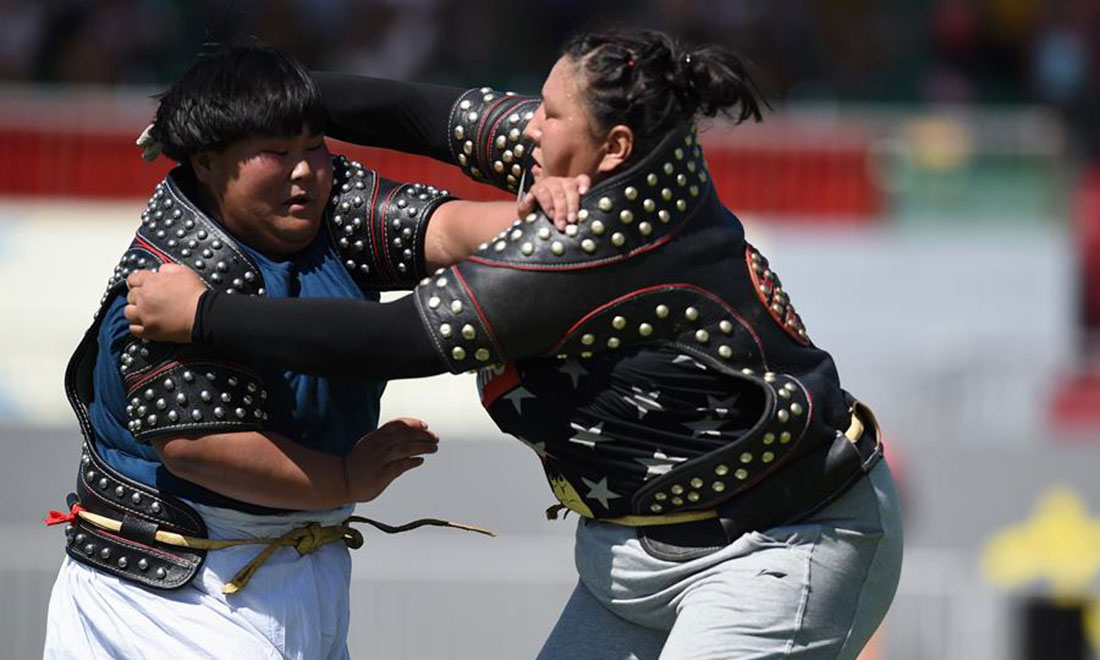Editor's Note:
China’s 10th ethnic games wrapped up in Ordos, Inner Mongolia Autonomous Region on August 17, which saw some 6,240 athletes compete in around 200 traditional sports events.
Single bamboo drifting, Mongolian wrestling and stilt races were among the interesting and unusual events at the 10th National Traditional Games of Ethnic Minorities of the People's Republic of China, which showcased the traditional sports of China’s 56 minority groups from August 9 to 17.
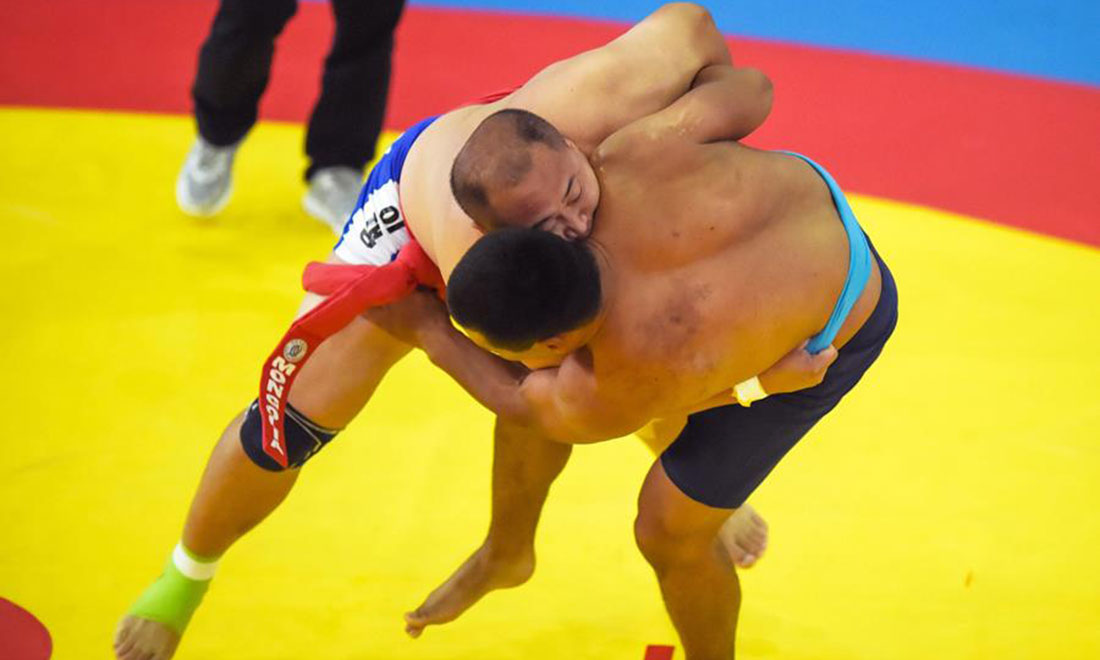 Jin Hailin from the Jilin delegation (left) grapples with a Guangdong Province contender in Korean-style wrestling, 87-kilogram weight class, on August 15, 2015. The games include six styles of wresting: Boke (Mongolian-style wrestling), Uyghur-style wrestling, Yi-style wrestling, Tibetan-style wrestling, Hui-style wrestling and Korean-style wrestling.
Jin Hailin from the Jilin delegation (left) grapples with a Guangdong Province contender in Korean-style wrestling, 87-kilogram weight class, on August 15, 2015. The games include six styles of wresting: Boke (Mongolian-style wrestling), Uyghur-style wrestling, Yi-style wrestling, Tibetan-style wrestling, Hui-style wrestling and Korean-style wrestling. 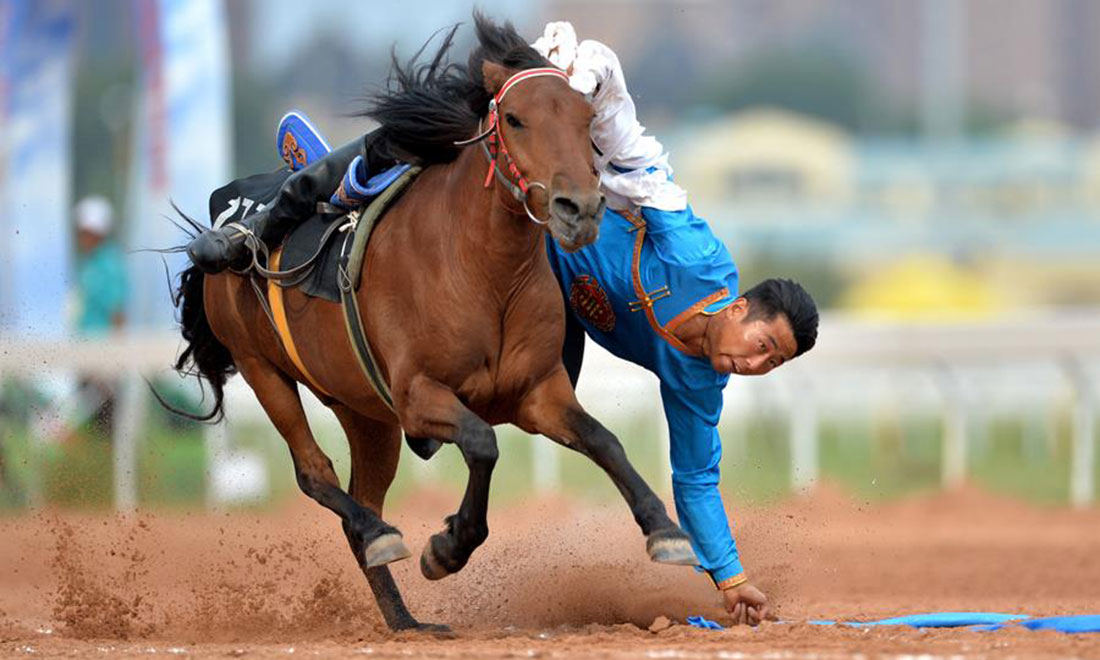 An Inner Mongolian athlete competes in an event on August 16, 2015 that requires participants to grab a hada, or ceremonial scarf, placed on the ground while atop a running horse. The sport is popular among Mongolian peoples. Contest rules require that all horses in competition must be China-bred horses and not from Arabian or British stock.
An Inner Mongolian athlete competes in an event on August 16, 2015 that requires participants to grab a hada, or ceremonial scarf, placed on the ground while atop a running horse. The sport is popular among Mongolian peoples. Contest rules require that all horses in competition must be China-bred horses and not from Arabian or British stock. 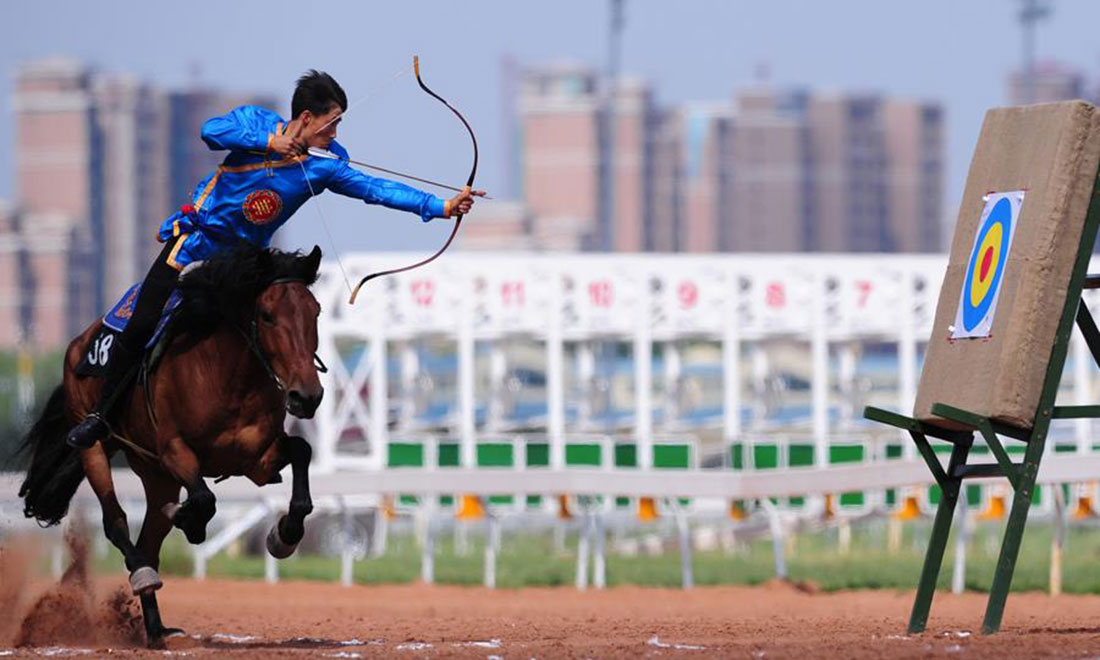 A Mongolian athlete shoots an arrow on horseback during the 10th National Traditional Games of Ethnic Minorities of China in Ordos, north China's Inner Mongolia Autonomous Region, August 12, 2015.
A Mongolian athlete shoots an arrow on horseback during the 10th National Traditional Games of Ethnic Minorities of China in Ordos, north China's Inner Mongolia Autonomous Region, August 12, 2015. 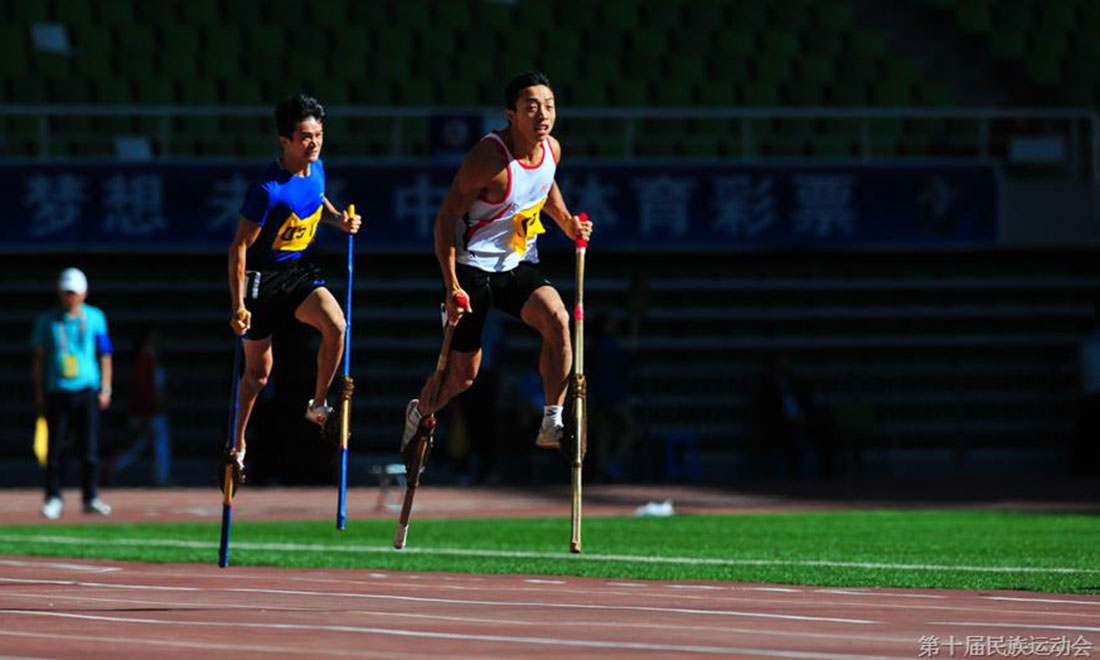 Zhou Zhenyong from Guangxi Zhuang Autonomous Region (left) and Sun Xianfeng from Hubei compete in the 200-meter stilt race competition on August 15, 2015. Originally, people of the Tujia and Miao ethnic groups use the stilt to walk in rainy days, and the Jing ethnic groups adopted it as a tool for catching fish.
Zhou Zhenyong from Guangxi Zhuang Autonomous Region (left) and Sun Xianfeng from Hubei compete in the 200-meter stilt race competition on August 15, 2015. Originally, people of the Tujia and Miao ethnic groups use the stilt to walk in rainy days, and the Jing ethnic groups adopted it as a tool for catching fish. 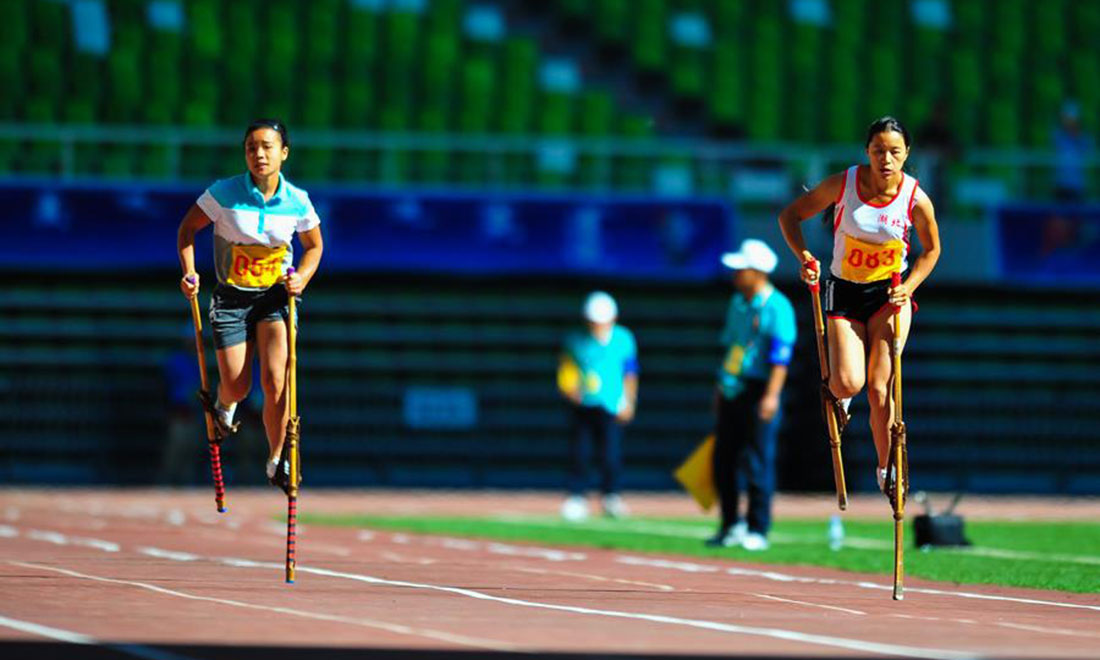 Qin Yixue from the Guangxi delegation (left) and Li Yanjiao from Hubei compete in the semifinals for the 200-meter stilt race on August 15, 2015. Stilt races have been included as an event since 2003.
Qin Yixue from the Guangxi delegation (left) and Li Yanjiao from Hubei compete in the semifinals for the 200-meter stilt race on August 15, 2015. Stilt races have been included as an event since 2003. 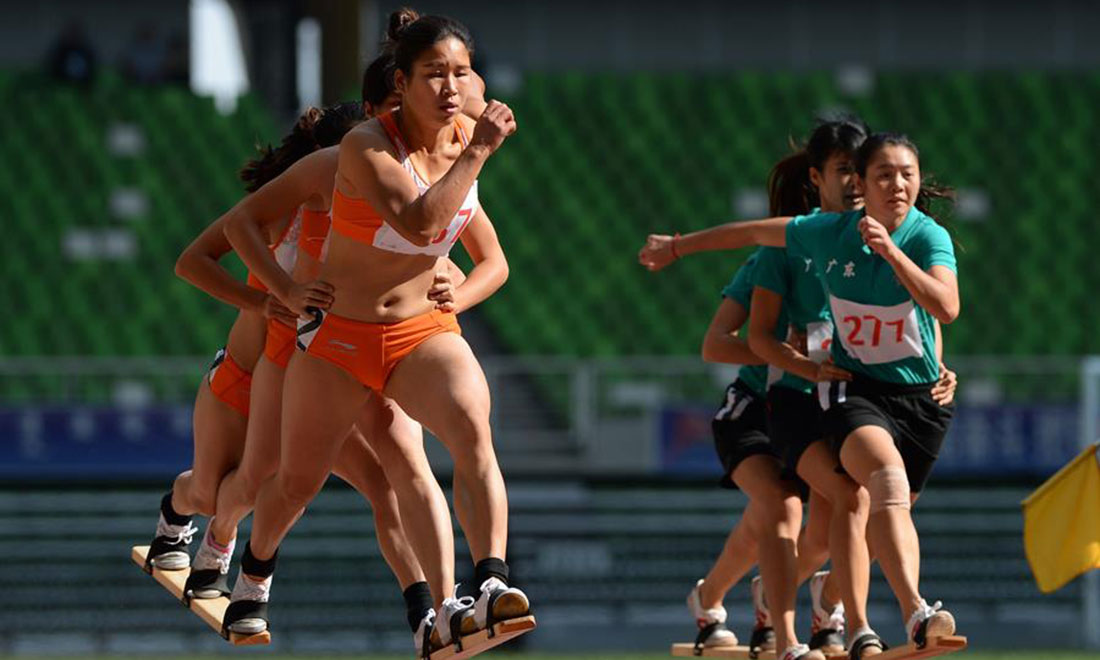 Athletes from the Jiangxi Province (left) and Guangdong Province delegations compete in the 60-meter broad-shoe race on August 12, 2015. The broad shoe is a wooden board with foot loops that requires teams of three runners to coordinate their strides. First popular in South China’s Guangxi Zhuang Autonomous Region, broad shoe racing became a competitive event during the Ming Dynasty (1368-1644).
Athletes from the Jiangxi Province (left) and Guangdong Province delegations compete in the 60-meter broad-shoe race on August 12, 2015. The broad shoe is a wooden board with foot loops that requires teams of three runners to coordinate their strides. First popular in South China’s Guangxi Zhuang Autonomous Region, broad shoe racing became a competitive event during the Ming Dynasty (1368-1644). 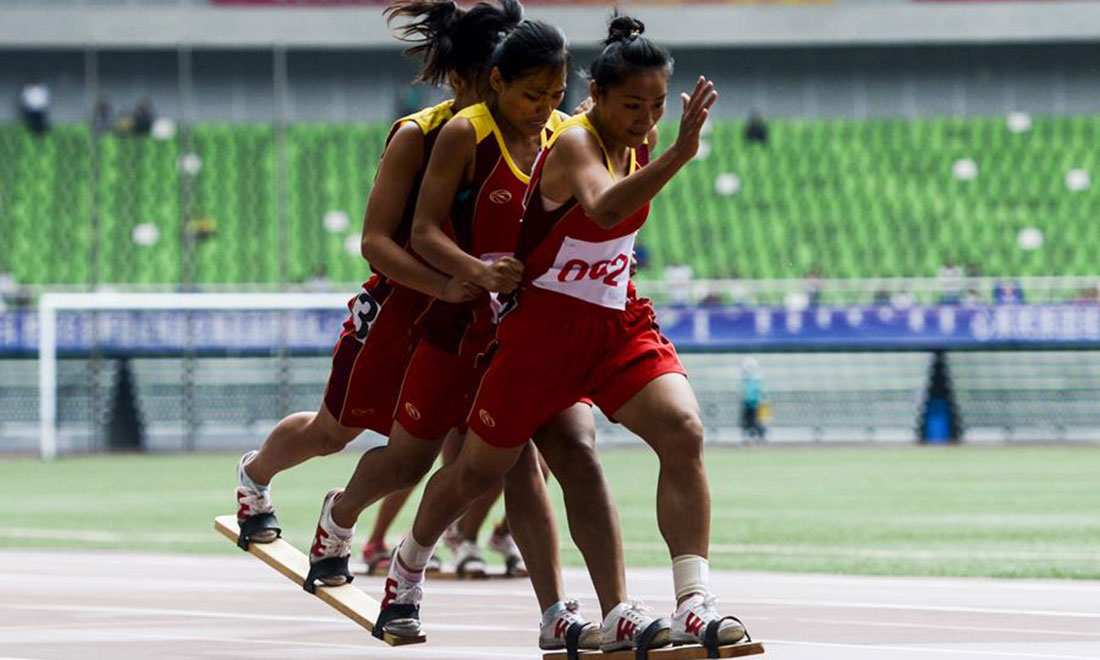 Lin Lifei (right) runs with her teammates from the Guangxi delegation in the 2x100-meters broad-shoe relay race on August 11, 2015. The event was included in the games in 2007.
Lin Lifei (right) runs with her teammates from the Guangxi delegation in the 2x100-meters broad-shoe relay race on August 11, 2015. The event was included in the games in 2007. 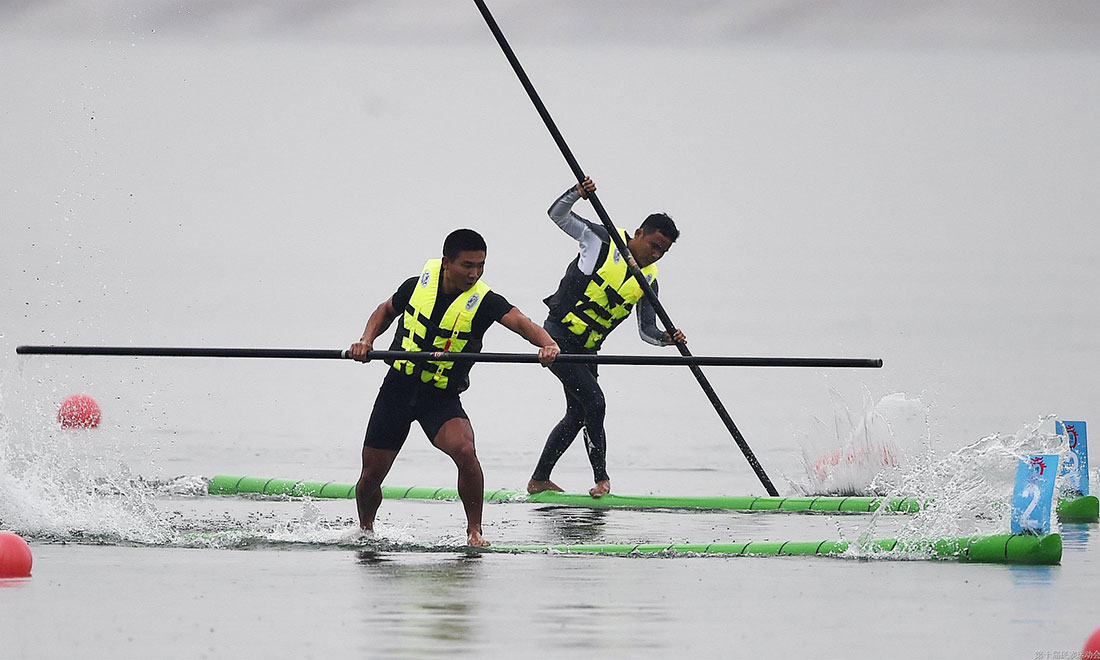 Nong Shujian from Chongqing (left) competes in the men’s 60-meter single bamboo drifting quarterfinals on August 10. Competitors stand on a 7.5-meter-long piece of bamboo and row with a thinner 4.5-meter bamboo pole. Nong won first place.
Nong Shujian from Chongqing (left) competes in the men’s 60-meter single bamboo drifting quarterfinals on August 10. Competitors stand on a 7.5-meter-long piece of bamboo and row with a thinner 4.5-meter bamboo pole. Nong won first place. 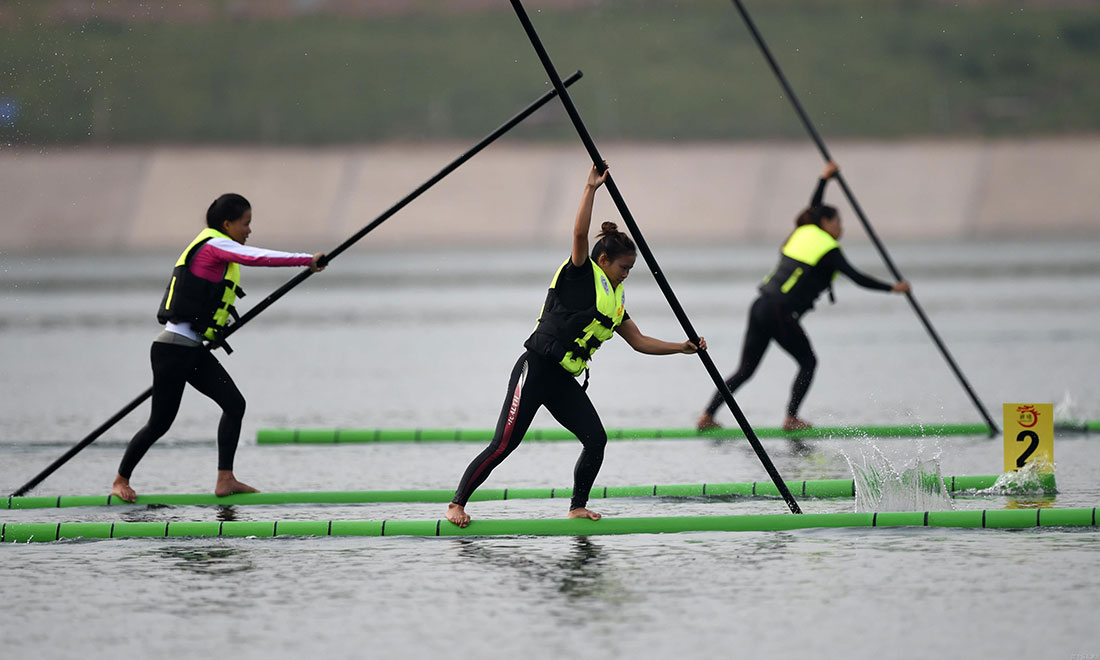 Three athletes compete in a women's 60-meters single bamboo drifting quarterfinals of on August 10, 2015. Single bamboo drifting, popular in Southwest China’s Guizhou Province, was included as a competition event in 2011.
Three athletes compete in a women's 60-meters single bamboo drifting quarterfinals of on August 10, 2015. Single bamboo drifting, popular in Southwest China’s Guizhou Province, was included as a competition event in 2011. 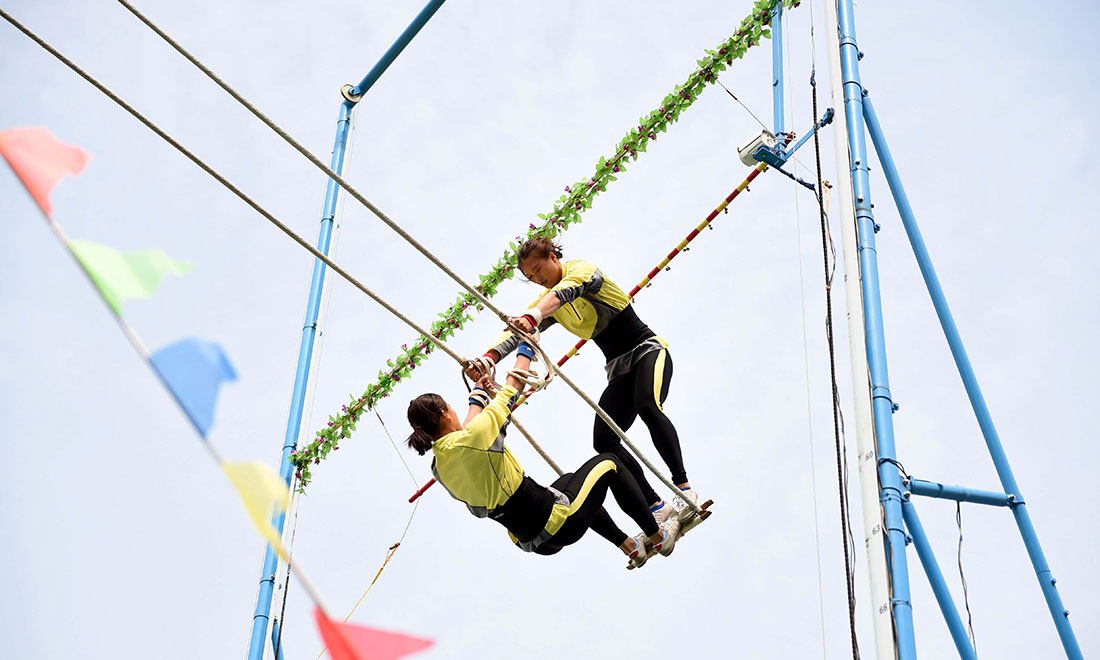 Wu Anzhen (right) and Fei Qianhong from the Hunan Province delegation compete in the 55kg-class swing event on August 12, 2015. The swing competition includes two events, height and bell touching. A team of two works up momentum together to compete for height or most rings of a highly-placed bell.
Wu Anzhen (right) and Fei Qianhong from the Hunan Province delegation compete in the 55kg-class swing event on August 12, 2015. The swing competition includes two events, height and bell touching. A team of two works up momentum together to compete for height or most rings of a highly-placed bell. 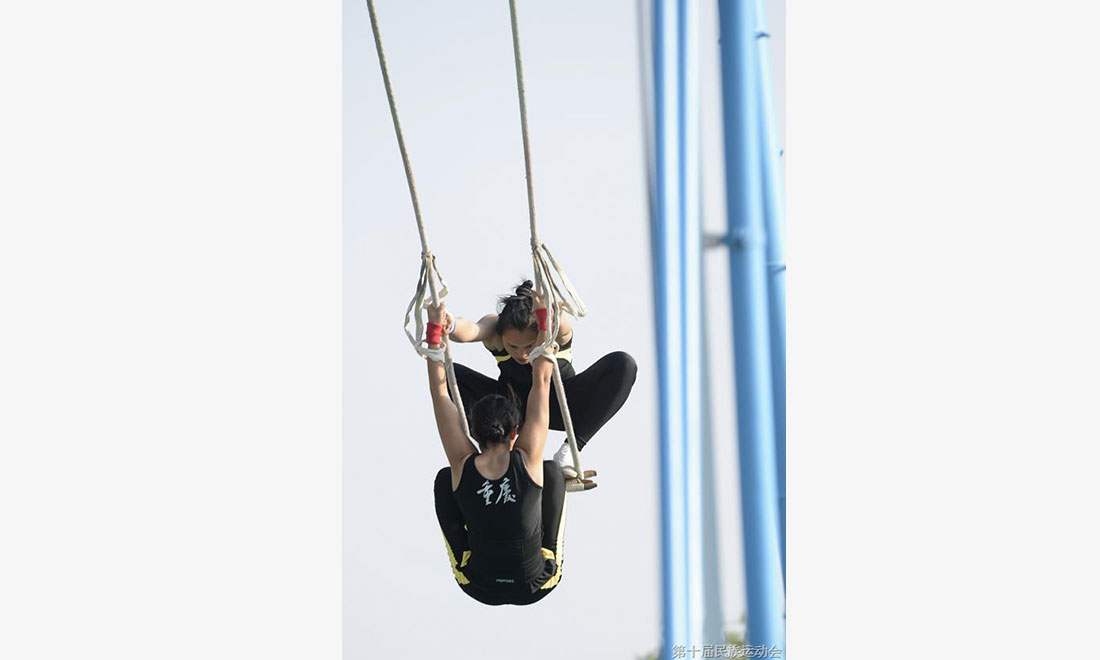 Wang Xiaoying (right) and Ma Qijin from the Chongqing delegation compete in the 55kg-class swing event on August 12, 2015. The team won the first place in the height category. The swing completion is open only to female athletes.
Wang Xiaoying (right) and Ma Qijin from the Chongqing delegation compete in the 55kg-class swing event on August 12, 2015. The team won the first place in the height category. The swing completion is open only to female athletes. 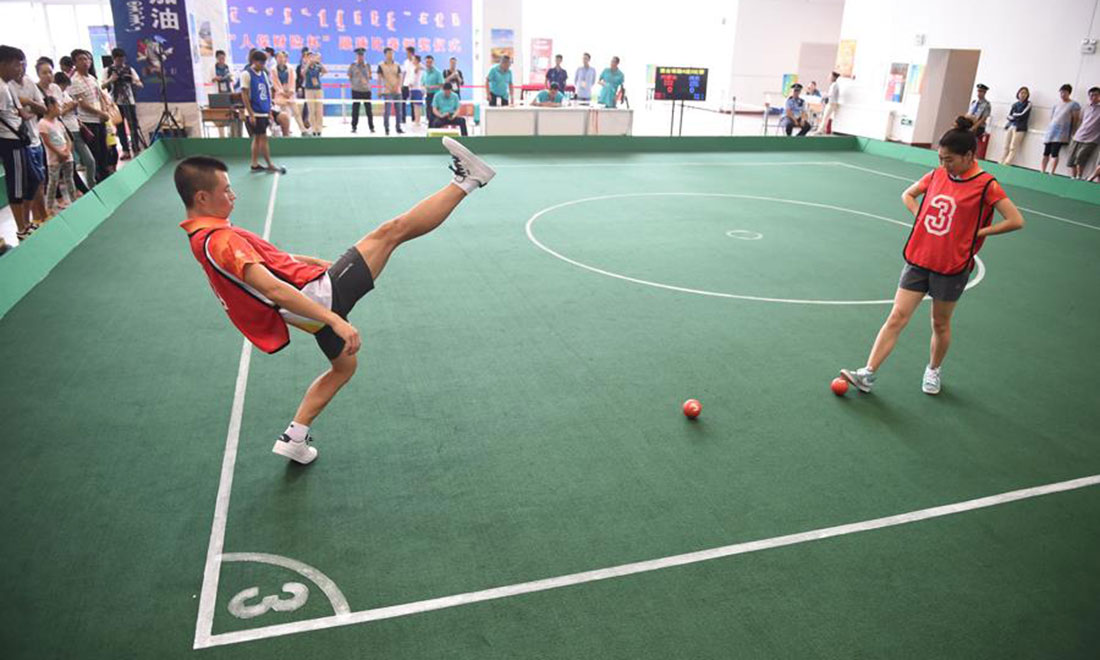 Han Liangliang (left) and Bao Xuezhen from the Inner Mongolia delegation warm up before the cuqiu mixed doubles final on August 11, 2015. Cuqiu is an ancient ball game dating back to the Warring States Period (475 BC–221BC). Cuqiu is popular among the Manchu, Mongolian and Hui ethnic groups, and was listed as a competition event in 1999.
Han Liangliang (left) and Bao Xuezhen from the Inner Mongolia delegation warm up before the cuqiu mixed doubles final on August 11, 2015. Cuqiu is an ancient ball game dating back to the Warring States Period (475 BC–221BC). Cuqiu is popular among the Manchu, Mongolian and Hui ethnic groups, and was listed as a competition event in 1999. 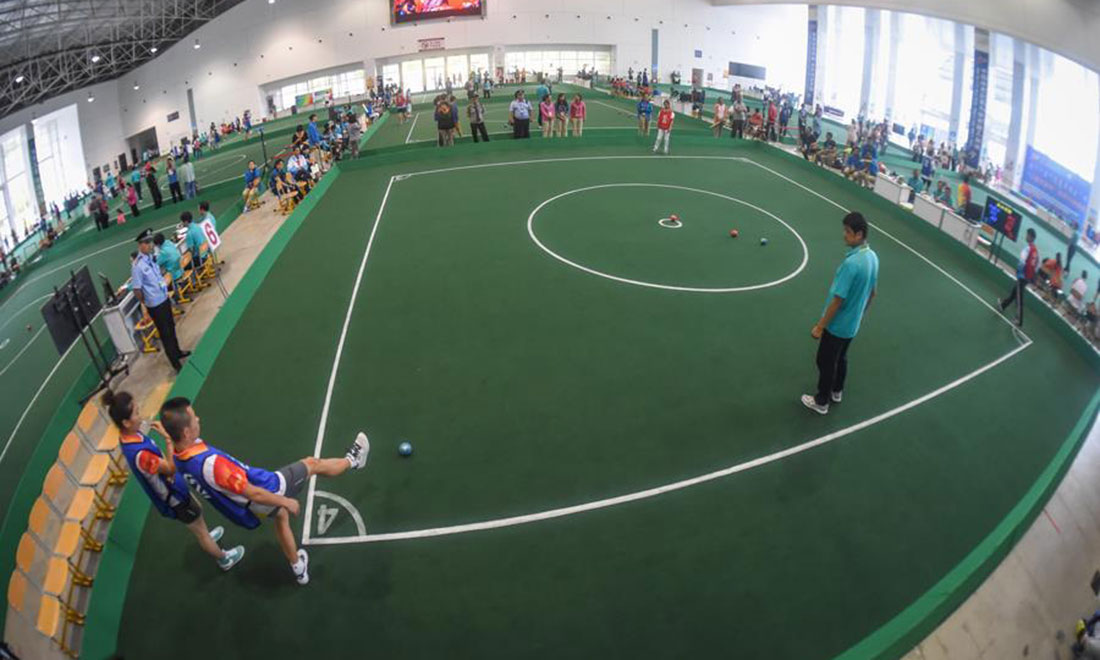 Han Liangliang (second from left) and Bao Xuezhen (left) from the Inner Mongolia delegation compete in a cuqiu mixed doubles match on August 11, 2015.
Han Liangliang (second from left) and Bao Xuezhen (left) from the Inner Mongolia delegation compete in a cuqiu mixed doubles match on August 11, 2015. 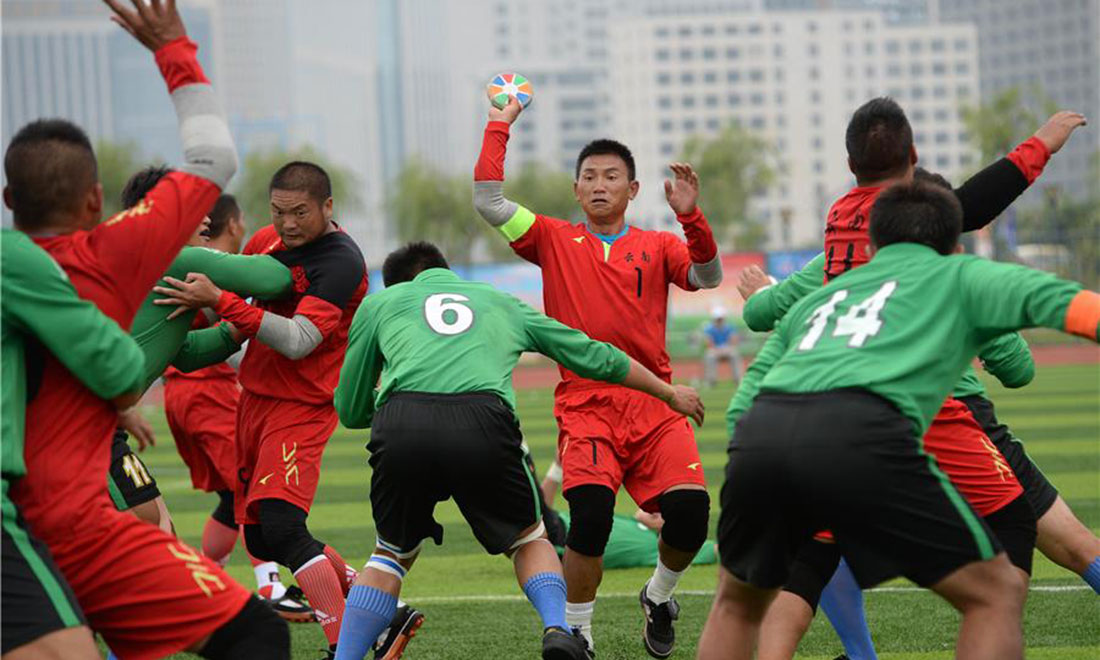 Zhao Yunguang (center, in red) from the Yunnan Province readies for a pass to his teammate in a huapao match against the Beijing team on August 15. Also called “Chinese rugby” for its similarity in rules, huapao players pass a colorful disc instead of a ball.
Zhao Yunguang (center, in red) from the Yunnan Province readies for a pass to his teammate in a huapao match against the Beijing team on August 15. Also called “Chinese rugby” for its similarity in rules, huapao players pass a colorful disc instead of a ball.  An Inner Mongolian athlete (center, in black) is tackled by opponents from the Guangxi team during a first-round huapao match on August 15. Guangxi beat Inner Mongolia 16 to 4. Huapao is popular among the Dong, Zhuang and Gelao ethnic groups.
An Inner Mongolian athlete (center, in black) is tackled by opponents from the Guangxi team during a first-round huapao match on August 15. Guangxi beat Inner Mongolia 16 to 4. Huapao is popular among the Dong, Zhuang and Gelao ethnic groups.















